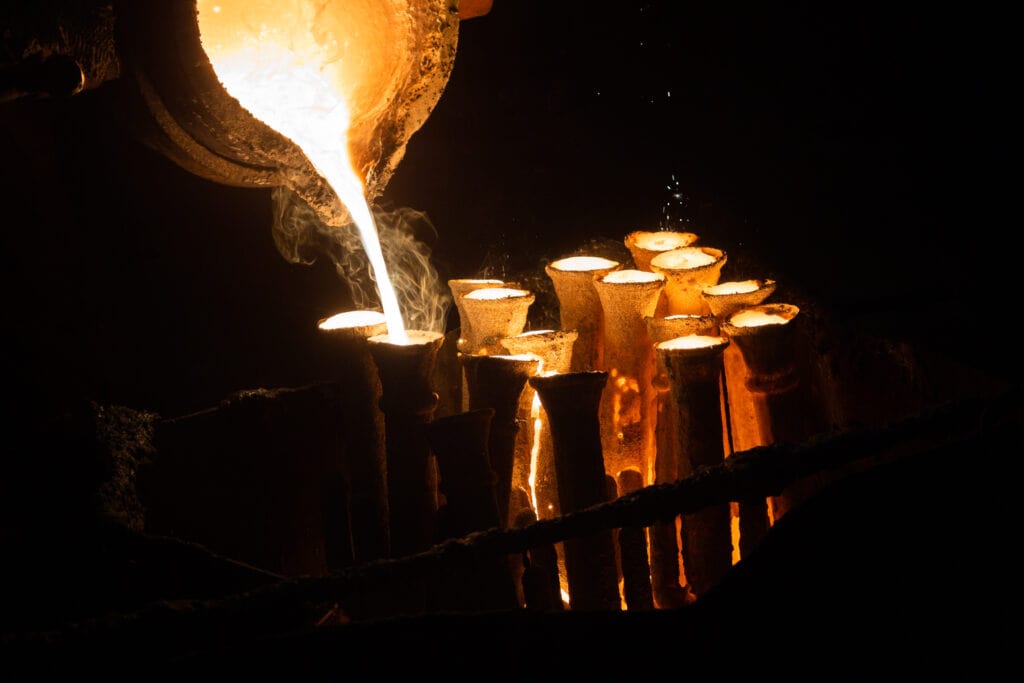What is Investment Casting?
Investment casting is a type of casting that uses wax patterns to shape a ceramic mold for casting purposes. Having been around for over 5000 years, it is one of the oldest metalcasting methods. It was originally used to create idols and jewelry using beeswax.
Investment casting differs from die casting because it uses disposable wax molds, whereas die casting uses reusable molds. Investment casting is still a casting method foundries use today.
Investment casting is a highly accurate form of metalcasting. The wax mold creation process makes the exact shape needed with a smooth surface finish. These castings are used in applications where precision is essential, such as aerospace parts, automotive parts, medical equipment, and more. It can also be used for other applications, but the main benefit is the ability to accurately make thin, small, and complex parts.
The Investment Casting Process
The investment casting process has several steps, making it the most labor-intensive form of casting. These steps include master pattern creation, wax pattern creation, mold creation, wax removal, pouring, shakeout, and finishing.
Master Pattern Creation
Because the wax model is destroyed during the casting process, having a master die pattern is vital if the piece is mass-produced. A “master die,” or an exact replica of the part, is created as a base for future wax patterns.
Wax Pattern Creation
Hot wax is injected into the master die pattern and left to solidify. Once solid, metalcasters can use the wax pattern for casting. If the part will be mass-produced, it is often added to a gating system (or “tree”) to hold multiple wax patterns for casting.
Mold Creation
The wax pattern is coated in a slurry typically consisting of refractory material such as silica, ceramic, plaster, or plastic and then left to dry. This process is repeated as often as needed until the mold is at the desired thickness.
Wax Removal
Once cured, the wax is melted from the mold by placing the ceramic shell in a furnace or autoclave, leaving a hollow shell in the desired casting shape.
Pouring
Molten metal is poured into the hot mold, filling the space with the desired pattern. The mold must be hot for the molten metal to reach the more narrow and tricky-to-reach parts of the mold to ensure accuracy.
Shakeout
Once the mold has sufficiently cooled, the mold is removed from the casting via hammering, vibration, blasting, or other methods. If there is a gating system, each casting is removed individually.
Finishing
The castings are then cleaned up and smoothed by grinding. Hand tooling and welding are performed if additional changes need to be made to the castings.
Advantages of Investment Casting
Accurate Finish
Due to the complicated nature of this process, the castings are much more dimensionally accurate and smooth than ones produced via other methods.
Detail
It can handle detailed, complex, or small parts—even parts with complex internal shapes, such as rotors or connectors.
Flexibility
All kinds of metals can be used. Some common ones are steel, aluminum, cobalt, and iron.
Disadvantages of Investment Casting
Upfront Cost
Investment casting has higher upfront costs than other types of casting. More specialized equipment, labor, and space are needed to start.
Size Limitations
While investment casting can be used to create large parts, generally, it does not exceed items over about 75 pounds. They also can not be smaller than 1.6mm.
Longer Process
There are more steps involved than other methods. As a result, investment casting takes longer, has more room for errors (and time spent fixing them), and is inefficient for making one-time-use parts.
Invest in GK Systems to Get the Most Out of Your Investment Casting System
Modernizing your investment casting system is essential to producing high-quality castings efficiently. Contact GK Foundry Systems today, and we’ll help you revolutionize your casting processes.

